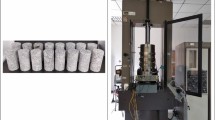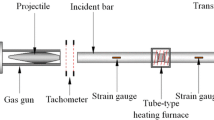Abstract
Based on experimental investigations, we propose a coupled elastoplastic damage model to simulate the mechanical behavior of granite under compressive stress conditions. The granite is taken from the Beishan area, a preferable region for China’s high-level radioactive waste repository. Using a 3D acoustic emission monitoring system in mechanical tests, we focus on the cracking process and its influence on the macroscopic mechanical behavior of the granite samples. It is verified that the crack propagation coupled with fractional sliding along the cracks is the principal mechanism controlling the failure process and nonlinear mechanical behavior of granite under compressive stress conditions. Based on this understanding, the coupled elastoplastic damage model is formulated in the framework of the thermodynamics theory. In the model, the coupling between damage and plastic deformation is simulated by introducing the independent damage variable in the plastic yield surface. As a preliminary validation of the model, a series of numerical simulations are performed for compressive tests conducted under different confining pressures. Comparisons between the numerical and simulated results show that the proposed model can reproduce the main features of the mechanical behavior of Beishan granite, particularly the damage evolution under compressive stress conditions.











Similar content being viewed by others
Abbreviations
- E:
-
Elastic modulus of intact rock
- \(\tilde{E}\) :
-
Elastic modulus of damaged rock
- v :
-
Poisson’s ratio
- ε e :
-
Elastic strain
- ε p :
-
Plastic strain
- ɛ v :
-
Volumetric strain
- σ 3 :
-
Minimum principal stress
- ω :
-
Damage variable
- k 0 :
-
Initial drained bulk of intact rock
- μ 0 :
-
Initial shear modulus of intact rock
- k(ω):
-
Effective drained bulk of damaged rock
- μ(ω):
-
Effective shear modulus of damaged rock
- H(e v):
-
Heaviside function of volumetric strain ɛ v
- p :
-
Mean stress (compressive stress is taken as positive)
- q :
-
Deviatoric stress
- θ :
-
Lode’s angle
- P a :
-
Normalizing coefficient in plastic yield surface
- C s :
-
Parameter in plastic yield surface
- η :
-
Parameter in plastic yield surface
- m :
-
Parameter in plastic yield surface
- η 0 and η m :
-
Initial and ultimate value of parameter η
- γ p :
-
Equivalent plastic shear strain
- b 1 :
-
Plastic hardening parameter
- b2 :
-
Plastic hardening parameter
- χ p :
-
Plastic hardening variable
- δ ij :
-
Second-order unit tensor
- μ c :
-
Parameter of plastic potential Q
- \(\bar{p}_{0}\) :
-
Variable of plastic potential Q
- C(ω):
-
Elastic stiffness tensor of damaged material
- ψp :
-
Plastic hardening energy
- λ p :
-
Plastic multiplier
- Y ω :
-
Damage conjugate force
- Y e ω :
-
Elastic damage conjugate force
- Y p ω :
-
Plastic damage conjugate force
- Y p,0 ω :
-
Threshold of plastic damage conjugate force
- B ω :
-
Parameter of damage criterion controlling the kinetics of damage evolution
- ω c :
-
Parameter of damage criterion that defines the asymptotic damage value
References
Andersson J, Strom A, Svemar C, et al. (2000) What requirements does the KBS-3 repository make on the host rock? Geoscientific suitability indicators and criteria for siting and site evaluation. In: Swedish Nuclear Fuel and Waste Management Co (SKB). Stockholm, TR-00-12
Barthelemy JF, Dormieux L, Kondo D (2003) Détermination du comportement macroscopic d’un milieu à fissures forttantes. C R Mécanique. 5(3):471–513
Cai M, Kaiser PK, Tasaka Y, Maejima T, Morioka H, Minami M (2004) Generalized crack initiation and crack damage stress thresholds of brittle rock masses near underground excavations. Int J Rock Mech Min Sci 41:833–847
Chang SH, Lee CI, Lee YK (2007) An experimental damage model and its application to the evaluation of the excavation damage zone. Rock Mech Rock Eng 40(3):245–285
Chen L, Shao JF, Huang HW (2010) Coupled elastoplastic damage modeling of anisotropic rocks. Comput Geotech 37:187–194
Chen L, Liu JF, Wang CP, Wang L, Wang XY, Wang J (2012) Study of acoustic emission characteristics of Beishan deep granite under different stress condition. Chin J Rock Mech Eng 31(suppl 2):3618–3624
Chen L, Liu JF, Wang CP, Liu J, Wang J (2014) Characterization of damage evolution in granite under compressive stress condition and its effect on permeability. Int J Rock Mech Min Sci (in revision)
Deudé V, June W (1987) An anisotropic theory of elasticity for continuum damage mechanics. Int J Fract 33:3–16
Fredrich JT, Wong TF (1986) Micromechanics of thermally induced cracking in three crustal rocks. J Geophys Res 91:12743–12764
Halm D, Dragon A (1996) A model of anisotropic damage by meso-crack growth; unilateral effect. Int J Damage Mech 5:384–402
Halm D, Dragon A (1998) An anisotropic model of damage and frictional sliding for brittle materials. Eur J Mech A Solids 17(3):439–460
International Atomic Energy Agency (1981) Underground disposal of radioactive wastes: basic guidenace. International Atomic Energy Agency, Vienna Safety series no. 54
Jia Y, Song XC, Duveau G, Su K, Shao JF (2007) Elastoplastic damage modelling of argillite in partially saturated condition and application. Phys Chem Earth 32:656–666
Ju JW (1989) On energy based coupled elastoplastic damage theories: constitutive modeling and computational aspects. Int J Solids Struct 25(7):803–833
Ju JW (1990) Isotropic and anisotropic damage variables in continuum damage mechanics. J Eng Mech Div ASCE 116(12):2764–2770
Ju JW, Lee X (1990) Micromechanical damage models for brittle solids. I: tensile loadings. J Appl Mech 117(7):1495–1514
Kachanov M (1982) A microcrack model of rock elasticity. Part I: frictional sliding on microcracks; Part II: propagation of microcracks. Mech Mater 1:19–41
Kachanov M (1994) Elastic solids with many cracks and related problems. In: Hutchinson J, Wu T (eds) Advanced in applied mechanics, 30. Adacemic Press, San Diego, pp 256–426
Krajcinovic D (1996) Damage mechanics. North-Holland, Amsterdam
Lee X, Ju JW (1990) Micromechanical damage models for brittle solids. II: compressive loadings. J Appl Mech 117(7):1515–1536
Lemaitre J (1992) A course on damage mechanics, 2nd edn. Springer, Berlin
Lemaitre J, Dufailly J (1987) Damage measurements. Eng Fract Mech 28(5/6):643–661
Lin QX, Liu YM, Tham LG, Tang CA, Lee PKK, Wang J (2009) Time-dependent strength degradation of granite. Int J Rock Mech Mining Sci 46:1103–1114
Liu JF, Chen L, Wang CP, Liu J, Wang J (2014) Characterizing the mechanical behavior of Beishan granite with different experimental methods. Int J Rock Mech Min Sci 69:50–58
Martin CD, Chandler NA (1994) The progressive failure of Lac du Bonnet granite. Int J Rock Mech Min Sci 31(4):643–659
Mazars J, Pijaudier-Cabot G (1989) Continuum damage theory-application to concrete. J Eng Mech 115:345–365
Murakami S, Kamiya K (1996) Constitutive and damage evolution equation of elastic brittle materials based on irreversible thermodynamics. Int J Mech Sci 39(4):473–486
National Standards Compilation Group of People’s Republic of China (2013) Standard for tests method of engineering rock masses (GB/T 50266-2013). China Plan Press, Beijing (in Chinese)
Nemat-Nasser S, Hori M (1993) Micromechanics: overall properties of heterogeneous materials. North-Holland, Amsterdam
Oda M, Takemura T, Aoki T (2002) Damage growth and permeability change in triaxial compression tests of Inada granite. Mech Mater 34:313–331
Pensée V, Kondo D, Dormieux L (2002) Micromechanical analysis of anisotropic damage in brittle materials. J Eng Mech ASCE 128(8):889–897
Shao JF, Chau KT, Feng XT (2006a) Modeling of anisotropic damage and creep deformation in brittle rocks. Int. J. Rock Mech Min Sci 43:582–592
Shao JF, Jia Y, Kondo D, Chiarelli AS (2006b) A coupled elastoplastic damage model for semi-brittle materials and extension to unsaturated conditions. Mech Mater 38(3):218–232
Singh M (2000) Applicability of a constitutive model to jointed block mass. Rock Mech Rock Eng 33(2):141–147
Wang J (2010) High-level radioactive waste disposal in China: update 2010. J Rock Mech Geotech Eng 2(1):1–11
Wong TF (1982) Micromechanics of faulting in westerly granite. Int J Rock Mech Min Sci 19:49–62
Xie SY, Shao JF (2014) An experimental study and constitutive modeling of saturated porous rocks. Rock Mech Rock Eng. doi:10.1007/s00603-014-0561-5
Yang Q, Li Z, Tham LG (2001) An explicit expression of the second-order fabric tensor dependent elastic compliance tensor. Mech Res Commun 28(3):255–260
Zhao XG, Wang J, Cai M, Ma LK, Zong ZH et al (2013) In-situ stress measurements and regional stress field assessment of the Beishan area, China. Eng Geol 163:26–40
Zhu WC, Tang CA (2004) Micromechanical model for simulating the fracture process of rock. Rock Mech Rock Eng 37(1):25–56
Acknowledgments
This work was supported by the China Atomic Energy Authority through the geological disposal program and the National Natural Science Foundation of China (No. 11202069 and 51374148).
Author information
Authors and Affiliations
Corresponding author
Rights and permissions
About this article
Cite this article
Chen, L., Wang, C.P., Liu, J.F. et al. Damage and Plastic Deformation Modeling of Beishan Granite Under Compressive Stress Conditions. Rock Mech Rock Eng 48, 1623–1633 (2015). https://doi.org/10.1007/s00603-014-0650-5
Received:
Accepted:
Published:
Issue Date:
DOI: https://doi.org/10.1007/s00603-014-0650-5




